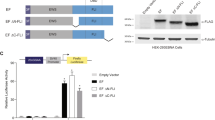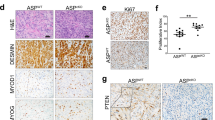Abstract
The 2;13 chromosomal translocation occurs in most cases of the cancer alveolar rhabdomyosarcoma (ARMS), and juxtaposes the genes encoding the PAX3 and FKHR transcription factors. The resulting chimeric protein PAX3-FKHR is a potent transcriptional activator, and is hypothesized to function as a dominant acting oncogene. To investigate its biological function, PAX3-FKHR was transduced into three immortalized murine cell lines in either a constitutive or inducible manner. These cells only tolerate expression of low PAX3-FKHR levels, which is sufficient for transformation in NIH3T3 cells. In contrast, higher PAX3-FKHR levels, which are comparable to the endogenous level expressed in ARMS cells, result in growth suppression. To determine as to which PAX3 functional domains are needed for growth suppression and transformation, inactivating mutations were introduced into the paired box and homeodomain of PAX3-FKHR. In these experiments, the homeodomain is necessary for transformation, but not growth suppression; whereas the paired box is not required for transformation but mediates growth suppression. In summary, our findings demonstrate that the transforming and growth suppressive activities of PAX3-FKHR are dominant at different activity levels and are mediated by distinct functional domains. These findings are consistent with the hypothesis that distinct expression pathways are operative in these opposing phenotypic end points.
This is a preview of subscription content, access via your institution
Access options
Subscribe to this journal
Receive 50 print issues and online access
$259.00 per year
only $5.18 per issue
Buy this article
- Purchase on Springer Link
- Instant access to full article PDF
Prices may be subject to local taxes which are calculated during checkout




Similar content being viewed by others
References
Barr FG . (1997). J. Pediatr. Hematol. Oncol., 19, 483–491.
Barr FG, Galili N, Holick J, Biegel JA, Rovera G and Emanuel BS . (1993). Nat. Genet., 3, 113–117.
Bennicelli JL, Edwards RH and Barr FG . (1996). Proc. Natl. Acad. Sci. USA, 93, 5455–5459.
Bernasconi M, Remppis A, Fredericks WJ, Rauscher FJ and Schafer BW . (1996). Proc. Natl. Acad. Sci. USA, 93, 13164–13169.
Berner JM, Forus A, Elkahloun A, Meltzer PS, Fodstad O and Myklebost O . (1996). Genes Chromosomes Cancer, 17, 254–259.
Bridge JA, Liu J, Qualman SJ, Suijkerbuijk R, Wenger G, Zhang J, Wan X, Baker KS, Sorensen P and Barr FG . (2002). Genes Chromosomes Cancer, 33, 310–321.
Bridge JA, Liu J, Weibolt V, Baker KS, Perry D, Kruger R, Qualman S, Barr F, Sorensen P, Triche T and Suijkerbuijk R . (2000). Genes Chromosomes Cancer, 27, 337–344.
Burel SA, Harakawa N, Zhou L, Pabst T, Tenen DG and Zhang DE . (2001). Mol. Cell. Biol., 21, 5577–5590.
Davis RJ and Barr FG . (1997). Proc. Natl. Acad. Sci. USA, 94, 8047–8051.
del Peso L, Gonzalez VM, Hernandez R, Barr FG and Nunez G . (1999). Oncogene, 18, 7328–7333.
Deneen B and Denny CT . (2001). Oncogene, 20, 6731–6741.
Fortin AS, Underhill DA and Gros P . (1997). Hum. Mol. Genet., 6, 1781–1790.
Kappen C, Schughart K and Ruddle FH . (1993). Genomics, 18, 54–70.
Lam PY, Sublett JE, Hollenbach AD and Roussel MF . (1999). Mol. Cell. Biol., 19, 594–601.
Littlewood TD, Hancock DC, Danielian PS, Parker MG and Evan GI . (1995). Nucleic Acids Res., 23, 1686–1690.
Matsuzaki H, Daitoku H, Hatta M, Tanaka K and Fukamizu A . (2003). Proc. Natl. Acad. Sci. USA, 100, 11285–11290.
Serrano M, Lin AW, McCurrach ME, Beach D and Lowe SW . (1997). Cell, 88, 593–602.
Tsokos M, Webber BL, Parham DM, Wesley RA, Miser A, Miser JS, Etcubanas E, Kinsella T, Grayson J, Glatstein E, Pizzo PA and Triche TJ . (1992). Arch Pathol Lab Med, 116, 847–855.
Wilson DS, Guenther B, Desplan C and Kuriyan J . (1995). Cell, 82, 709–719.
Xu HE, Rould MA, Xu W, Epstein JA, Maas RL and Pabo CO . (1999). Genes Dev., 13, 1263–1275.
Acknowledgements
This work was supported by Grants CA64202 and CA71838 (to FGB) from the National Cancer Institute.
Author information
Authors and Affiliations
Corresponding author
Rights and permissions
About this article
Cite this article
Xia, S., Barr, F. Analysis of the transforming and growth suppressive activities of the PAX3-FKHR oncoprotein. Oncogene 23, 6864–6871 (2004). https://doi.org/10.1038/sj.onc.1207850
Received:
Revised:
Accepted:
Published:
Issue Date:
DOI: https://doi.org/10.1038/sj.onc.1207850
Keywords
This article is cited by
-
PAX3-FOXO1 uses its activation domain to recruit CBP/P300 and shape RNA Pol2 cluster distribution
Nature Communications (2023)
-
Regulatory landscape fusion in rhabdomyosarcoma through interactions between the PAX3 promoter and FOXO1 regulatory elements
Genome Biology (2017)
-
Alveolar rhabdomyosarcoma – The molecular drivers of PAX3/7-FOXO1-induced tumorigenesis
Skeletal Muscle (2012)
-
Carnitine palmitoyltransferase 1A (CPT1A): a transcriptional target of PAX3-FKHR and mediates PAX3-FKHR–dependent motility in alveolar rhabdomyosarcoma cells
BMC Cancer (2012)
-
Alternate PAX3 and PAX7 C-terminal isoforms in myogenic differentiation and sarcomagenesis
Clinical and Translational Oncology (2011)



